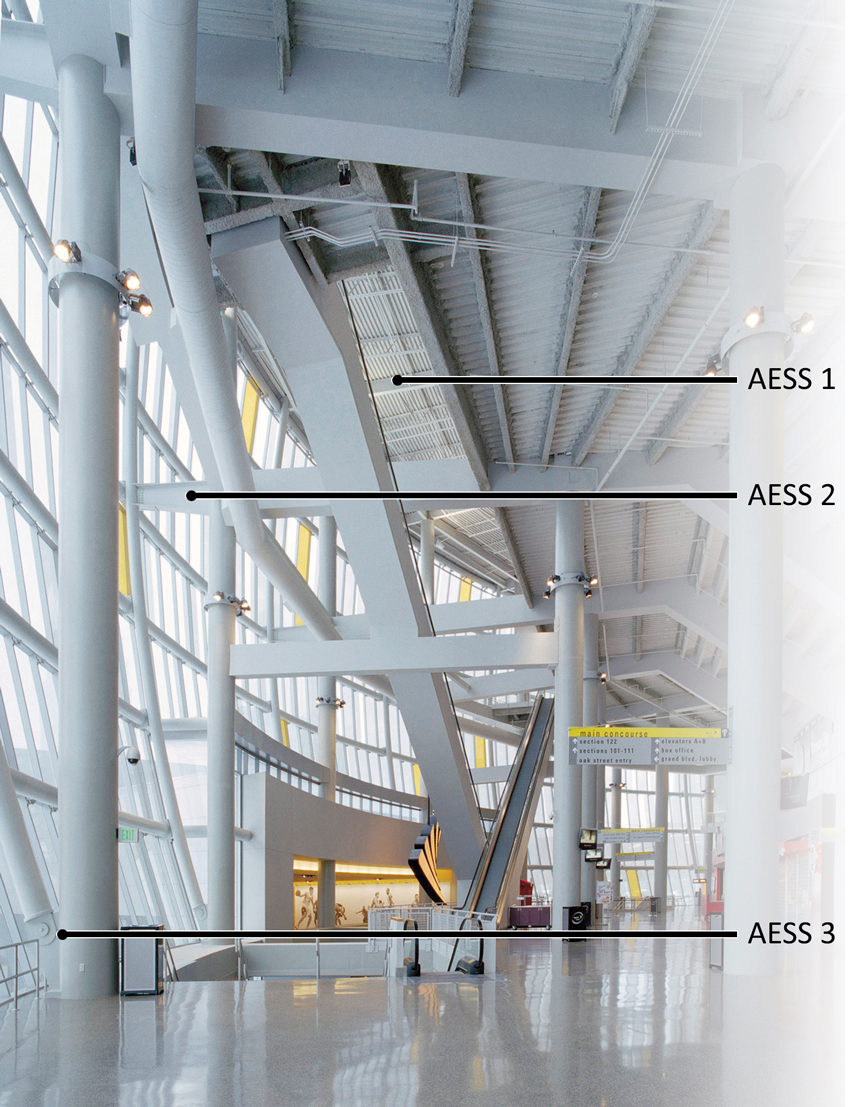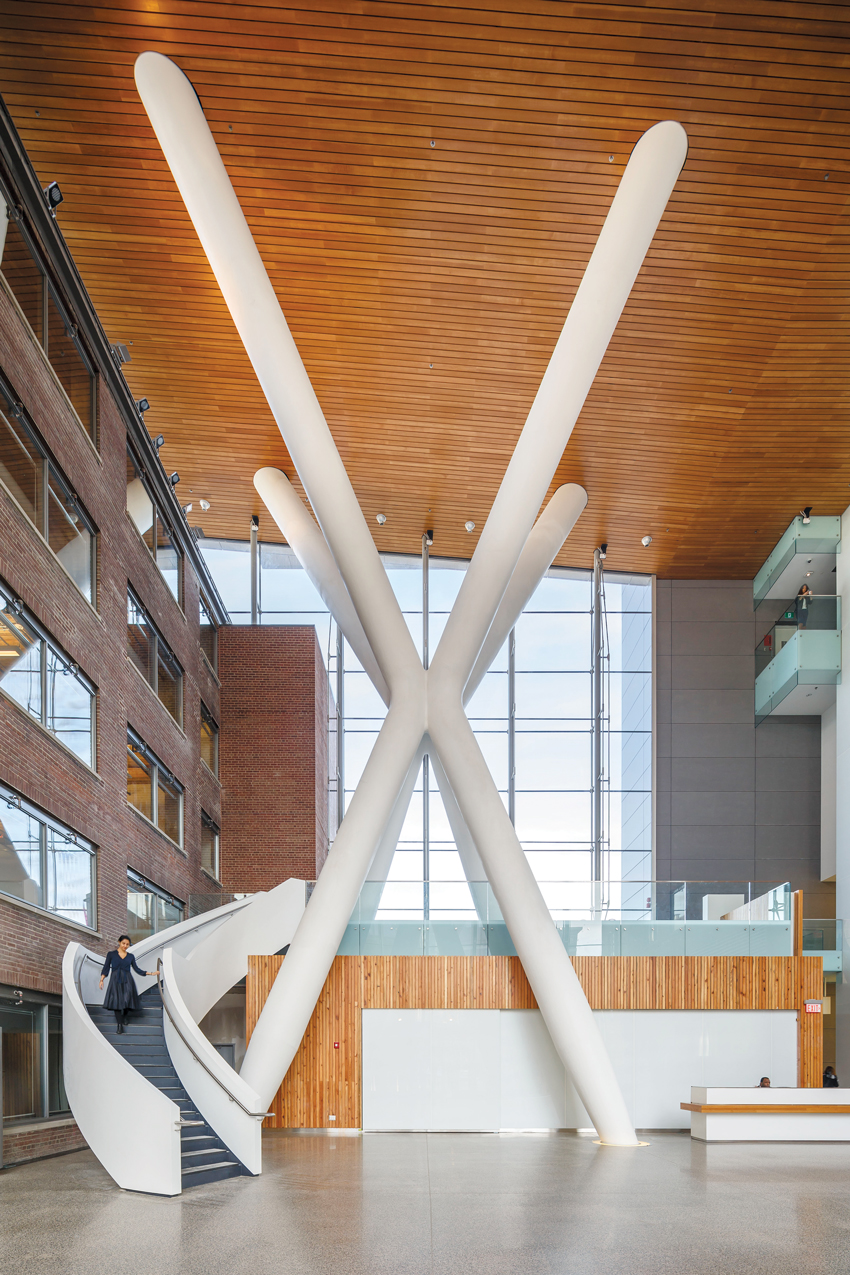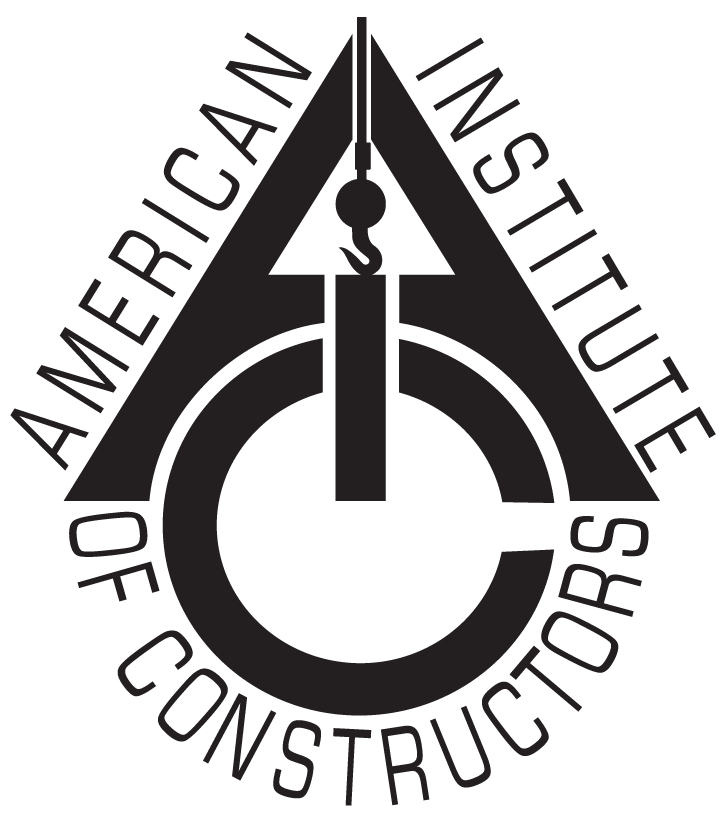This CE Center article is no longer eligible for receiving credits.
Style
There are two basic styles that govern the design intent with AESS: tectonic and plastic. A tectonic look is more expressive of the details that showcase the steel assembly and tends to emphasize bolted construction. A plastic aesthetic is uniform and smooth, using more welded or cast connections for a near-seamless appearance. The approach to the design style is an integral part of determining which AESS category is suitable based on the desired level of finish.
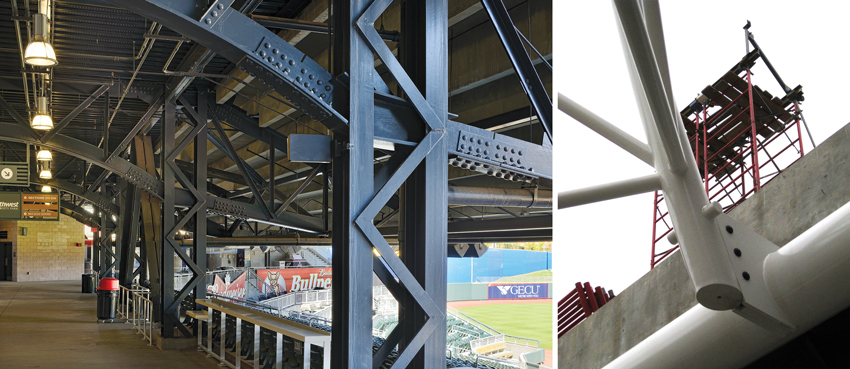
Photo courtesy of Walter P. Moore/Brian Wancho (left); © Skidmore, Owings & Merrill LLP (right)
The Southwest University Park stadium represents a more tectonic style (left), emphasizing bolts and connections. The intersection of multiple AESS members in the close-up image of the Loyola’s Institute of Environmental Sustainability Ecodome (right) are much more plastic, seamless, and smooth.
Adjacency
Structural steel is an ideal material for achieving tight tolerances, as it is fabricated with great precision. The 2016 AISC Code of Standard Practice distinguishes between standard tolerances and tighter tolerances with different AESS categories. Depending on the composition of the structure, tighter tolerances may or may not be necessary.
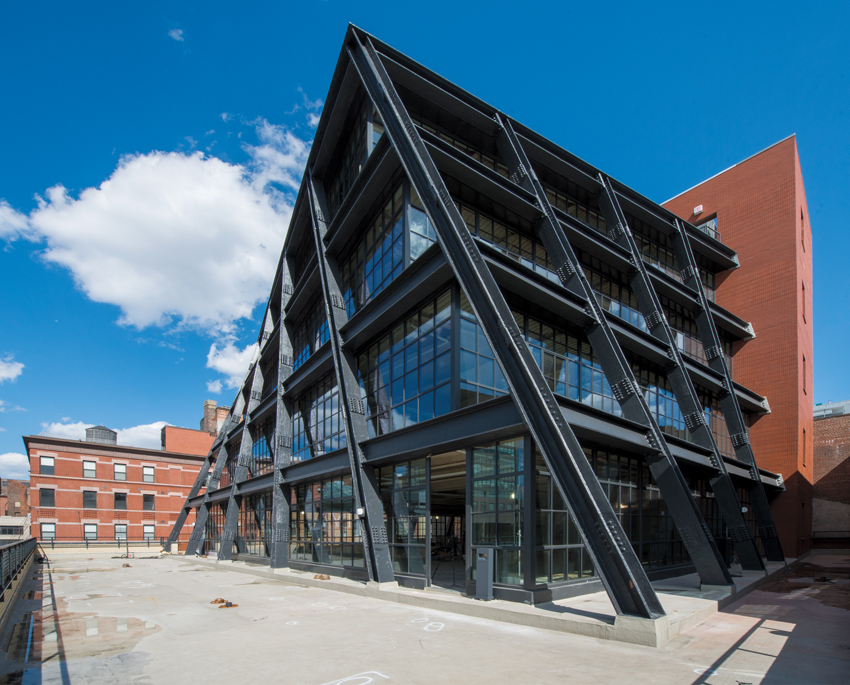
Photo courtesy of Gilsanz Murray Steficek
837 West Washington in New York City faced the challenge of designing to tight tolerances and straightness requirements so that all steel members would precisely align in this visibly twisting form. The exoskeleton structure is exposed to the exterior and requires additional applied treatment to prevent corrosion.
Several factors have a direct impact on the selection of an AESS category. Coordination during the design phase can be better facilitated by understanding the context that surrounds the expression of steel.
Choosing a Category
There are five categories which identify the level of AESS for a project:
- AESS 1: Basic Elements
- AESS 2: Feature Elements not in Close View
- AESS 3: Feature Elements in Close View
- AESS 4: Showcase Elements
- AESS C: Custom Elements
More requirements and therefore typically greater costs are inherent as the AESS category number increases. AESS C is Custom and could require fewer levels of finish than Basic Elements in AESS 1, or go even further beyond what is included in Showcase Elements of AESS 4. When choosing AESS C, more information should be included in the drawings and specifications to clarify the intent. It is required that one or more of these five AESS categories be annotated in the contract documents when AISC 303-16 is referenced as a standard.
“Section 10 of the 2016 AISC Code of Standard Practice provides specifiers with a much clearer roadmap to convey what they are looking for,” acknowledges Babette Freund with fabricator Universal Steel of North Carolina. Freund serves as chair of the Code of Standard Practice Committee to recognize and document standards within the U.S. structural steel industry to meet the expectations of design between fabricators and designers. Larry Kloiber, PE, who serves on the committee with Freund, encourages architects to consider the appearance they really need to achieve for the design intent prior to selecting an AESS category.
AESS 1: Basic Elements
By default, AESS 1 is the minimum treatment of exposed steel beyond standard fabrication of structural steel. This category is typically the lowest cost of the AESS categories and also serves as a prerequisite for AESS categories 2, 3, and 4. There are aspects of AESS 1 that meet the same requirements of standard fabrication. For example, the tolerances required for standard structural steel are the same for AESS 1 and can be referenced in the 2016 AISC Code of Standard Practice, available for free download at www.aisc.org/freepubs.
Surface preparation in AESS 1 is different from standard fabrication, as the exposed steel must receive commercial blast cleaning to meet the provisions of SSPC SP 6. The Society for Protective Coatings (SSPC) sets the standards for coatings and protection on structural steel. The SP 6 standard requires steel be cleaned of oil, grease, dust, oxides, rust, etc. In order to complete this surface preparation, weld spatter and similar surface discontinuities must be removed and sharp edges ground smooth. Specifications for paint and coatings should be thoroughly reviewed for use with the required surface preparation of AESS members.
Consistency of appearance between components is also a key strategy when specifying AESS. The AESS 1 Category requires that bolt heads be consistently located on the same side of a member as well as on adjacent steel members. The goal is to provide a uniform appearance beyond the standard requirements of structural steel.
When steel components are welded together, there may not always be a need for a continuous weld per the structural design. Visually, however, the appearance of a continuous weld is more desirable than intermittent welds. AESS 1 requires that all welds are to appear continuous and can be caulked, filled, or additionally welded to achieve this look. The projection of welds can be no higher than 1/16-inch above the surface.
This webinar is part of the Steel Academy
Expressing the structural integrity of a building is both a meaningful and impactful message in architecture. Today, many architects integrate architecturally exposed structural steel (AESS) in their designs to give identity and recognition to a building. Diligent coordination must take place among the design professionals and contractors to achieve a higher degree of finish desired for the structure. It is understood that these efforts are no simple task. New guidelines have been published in 2016, on behalf of the U.S. structural steel industry, to streamline the process of communication and documentation. In this course, design professionals will learn the tools to achieve their design and construction goals with a new category system for AESS.

Photo courtesy of Skidmore, Owings & Merrill LLP/© Scott Frances, OTTO
Lee Hall III, Clemson University, Clemson, South Carolina
The Code of Standard Practice
Structural steel has long been recognized for its flexibility in member shape and size, durability of material, and high strength-to-weight ratio. Since the 1980s, AESS has become more widely used and continues to grow in popularity by providing architects and engineers with a common medium for building design and expression. The American Institute of Steel Construction (AISC), which establishes the standards for steel construction in the United States, bases its guidelines on accepted industry practices. Since 1924, the AISC Code of Standard Practice has provided acceptable standards for contracting structural steel among owners, architects, engineers, general contractors, fabricators, detailers, and erectors.

Photo courtesy of Skidmore, Owings & Merrill LLP/© Scott Frances, OTTO
Lee Hall III at Clemson University incorporates AESS as an educational example of elegantly expressing the method of support for the building with the steel structural system. Slender “tree columns” draw attention to the building exterior, acting as feature elements that create an identity with purpose. This addition to the College of Architecture, Arts, and Humanities is a display of clarity between architecture and engineering, as well as an expression of fine craftsmanship.
The 2016 AISC Code of Standard Practice, an approved ANSI document AISC 303-16, implements a defined approach to specifying AESS in the contract documents by using five categories (AESS 1, 2, 3, 4, and C) to differentiate levels of steel fabrication and erection (see category matrix and image chart provided later in course). As the numbers in this tiered system rise, the cost and time for fabrication and erection typically also increase. A similar approach was adopted in the Canadian Code of Standard Practice in 2009 with the CISC Code of Standard Practice for structural steel, seventh edition. Previous versions of the codes did not define the terms of AESS as distinctly, leaving room for interpretation and cost escalation. The 2016 document, AISC 303-16, may be referenced as a standard in contract documents prior to municipalities adopting it.
The new guidelines establish the same level of expectations between designers, fabricators, and erectors for the visual appearance of architecturally exposed structural steel in the design. The category system provides architects with a method of articulating AESS on their projects with a much clearer understanding of deliverables.

Photo courtesy of American Institute of Steel Construction (AISC)
Pictured is a steel beam, recently cut to size and the ends coped per the standard requirements of the AISC Code of Standard Practice for structural steel. The edges have not been ground smooth. Etched numbers and heat marks are visible from the fabrication process. This member is not specified to meet AESS finishes.
AESS vs. Exposed Structural Steel: What's the Difference?
The 2016 AISC Code of Standard Practice defines structural steel as elements that are required to support the design loads of a building and fit within the components of a structural frame. For clarity, the AESS category system is typically only applied to fabricated structural steel as referenced in Section 2.1 of the code: anchor rods, base plates, beams, bracing, canopy framing, columns, connection materials, crane stops, girders, lintels, posts, shear stud connectors, trusses, etc. Unfinished, reused, galvanized, or weathering steel may all be fabricated with AESS requirements.
AESS is a step beyond standard fabrication and erection. During fabrication, shipment, and erection, extra care is taken to avoid blemishes and unwanted surface appearance when handling the steel and removing temporary braces or fixtures. Additionally, all backing and runoff tabs are removed, and welds are to be ground smooth for those areas. Basic unpainted steel must also be cleaned of oil, grease, dirt, and loose mill.
There are “other steel, iron, or metal items” that are not typically specified under AESS, though there may be exceptions depending on project requirements. Cables, castings, catwalks, chutes, cold-formed steel products, corner guards, flagpole support, grating, handrail, ladders, ornamental metal, stacks, stairs, steel deck, open-web steel joists, joist girders, trenches, etc. are examples of components that do not typically receive AESS identification. Reference Section 2.2 of the 2016 AISC Code of Standard Practice for the full list, available for free download at www.aisc.org/freepubs.
Coordination, Coordination, Coordination
Everyone in the building industry is familiar with the phrase “location, location, location.” When architecturally exposing the structure as an integral part of the design intent, keep in mind the significance of the three Cs: coordination, coordination, coordination. While the architect chooses the locations of AESS in a project, the structural engineer should document it. According to Bill Andrews, SE, a principal at structural engineering firm Walter P. Moore, fabricators and detailers will typically look to the structural drawings in the contract documents as the primary source of information for structural steel, including AESS. This methodology saves time and costs during construction, with the intent of consolidating references to AESS as much as possible. It is of utmost importance that successful coordination between these disciplines takes place to ensure the contract documents are bid per the design intent.
Equally imperative is selecting the correct category for all AESS components in a project. Per the 2016 AISC Code of Standard Practice, it is required that all AESS is identified by categories 1, 2, 3, 4, or C. “This is a dramatic improvement over the previous code edition [in 2010],” says Andrews, “in terms of better clarity, articulating expression...and giving everyone a better understanding of relative costs when choosing AESS and at what level.” Sufficient coordination and understanding of best practices are essential to keeping a project within budget and schedule.
The Impact of Context
There are many factors that influence the level of finish and detailing on an exposed member. It is important to understand the context surrounding the exposed steel before choosing an AESS category. The following explains which elements impact AESS and how it is perceived in the built environment: member visibility, viewing distance, location, lighting, coatings, style, and adjacency.
Member Visibility
Simply put, if it is not readily visible, there is no need to identify exposed steel as AESS. There are often conditions where one side of an exposed steel column or braced frame may be blocked from view by a wall or other component. It is possible to only note a specific AESS category on the side of an exposed member that is visible to view. Specifying AESS incurs more time and care during design, fabrication, and erection and should only be spent on portions of the project that are visible and prominent. Identifying specific locations for AESS takes careful consideration, but thoughtful analysis can greatly reduce costs and schedule during construction.
Viewing Distance
Details tend to disappear from the naked eye the further away they are located. When an object is beyond 20 feet, the distinction between components is not as clearly seen as when it is within reach. Consider objects 100 feet away from the closest point of view and the level of visible detail is even less distinct. The category system for AESS recognizes that viewing distance is critical to the level of fabrication and erection required for structural steel. The 20-foot viewing distance separates categories AESS 2 from AESS 3.
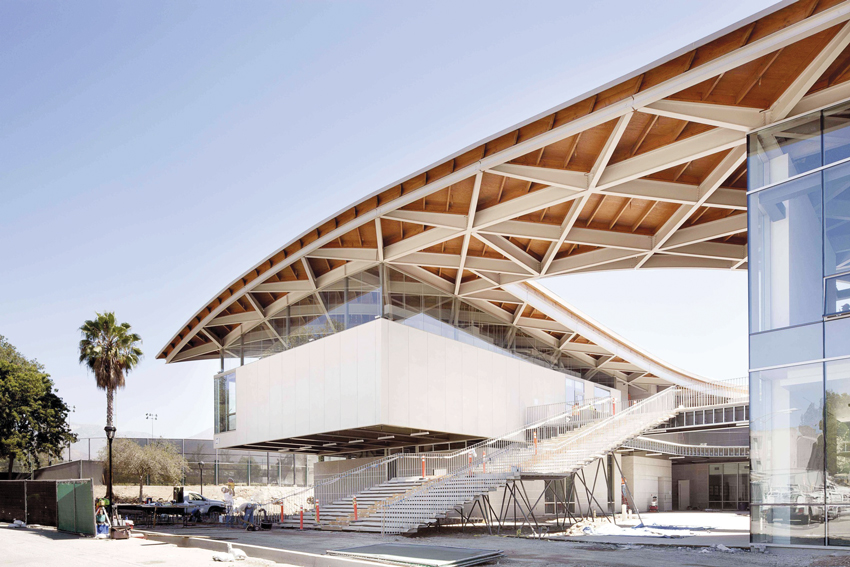
Photo courtesy of wHY Architecture/Jeremy Bitterman
The Pomona College Studio Art Hall in Claremont, California, exposes the steel roof structure as an aesthetic feature visible from below. The height of the steel diagrid is well over 20 feet from the typical viewing distance at ground. The project was completed in 2015, prior to the implementation of the AESS category system in the 2016 AISC Code of Standard Practice. AESS Category 2 could have been specified for the roof structural expression as the appropriate level of fabrication.
Location
Whether AESS is placed interior or exterior makes a significant impact to the type of coatings and protections selected for the member in addition to how it is detailed. If placed on the exterior of a building, the exposed steel must withstand more corrosive or harsh climate conditions. Additional surface preparation and protective coatings are often implemented to promote long-lasting AESS. Methods of detailing at joints or connections must also take special care to keep water out to avoid rusting of steel members.
Lighting
According to Steve Weiss, principal and founder of Weiss Architects, lighting typically has the greatest impact on interior AESS, whereas sight lines are the most important for AESS located on the exterior. Details are not as visible in high ceilings with low lighting, but when elements are brightly lit, they may tend to expose more texture and blemishes on the surface. The location and type of lighting with relation to AESS components should be determined prior to specifying the appropriate category.

Photo courtesy of Thornton Tomasetti/Bess Adler
AESS steel trees are the feature elements in the Brookfield Place Entry Pavilion in New York City. Uplighting the structural elements creates a dramatic effect but also highlights the importance of surface finish. Welds were ground smooth and made flush with the exposed surface for a cleaner aesthetic. Additionally, fitting multiple steel pipes together in the Brookfield Place Entry Pavilion necessitated stringent erection tolerances for the sculptural tree columns. These showcase elements typically fit the requirements of AESS Category 4.
Coatings
The selection of a coating, whether it be paint or intumescent fire protection, should be coordinated with the location and lighting intent for an AESS member. “Glossy coats tend to show every imperfection and surface variation,” says Larry Kloiber, PE, vice president at fabricator shop LeJeune Steel. A glossy coat combined with bright accent lighting within a close view range requires greater care and surface preparation for AESS. A thicker intumescent coating or matte finish tends to cover surface marks and blemishes, thereby reducing the need for certain characteristics of surface preparation to the steel. Kloiber stresses that it is always important to keep in mind how the material will be viewed, as it will impact the AESS category specified.
Style
There are two basic styles that govern the design intent with AESS: tectonic and plastic. A tectonic look is more expressive of the details that showcase the steel assembly and tends to emphasize bolted construction. A plastic aesthetic is uniform and smooth, using more welded or cast connections for a near-seamless appearance. The approach to the design style is an integral part of determining which AESS category is suitable based on the desired level of finish.

Photo courtesy of Walter P. Moore/Brian Wancho (left); © Skidmore, Owings & Merrill LLP (right)
The Southwest University Park stadium represents a more tectonic style (left), emphasizing bolts and connections. The intersection of multiple AESS members in the close-up image of the Loyola’s Institute of Environmental Sustainability Ecodome (right) are much more plastic, seamless, and smooth.
Adjacency
Structural steel is an ideal material for achieving tight tolerances, as it is fabricated with great precision. The 2016 AISC Code of Standard Practice distinguishes between standard tolerances and tighter tolerances with different AESS categories. Depending on the composition of the structure, tighter tolerances may or may not be necessary.

Photo courtesy of Gilsanz Murray Steficek
837 West Washington in New York City faced the challenge of designing to tight tolerances and straightness requirements so that all steel members would precisely align in this visibly twisting form. The exoskeleton structure is exposed to the exterior and requires additional applied treatment to prevent corrosion.
Several factors have a direct impact on the selection of an AESS category. Coordination during the design phase can be better facilitated by understanding the context that surrounds the expression of steel.
Choosing a Category
There are five categories which identify the level of AESS for a project:
- AESS 1: Basic Elements
- AESS 2: Feature Elements not in Close View
- AESS 3: Feature Elements in Close View
- AESS 4: Showcase Elements
- AESS C: Custom Elements
More requirements and therefore typically greater costs are inherent as the AESS category number increases. AESS C is Custom and could require fewer levels of finish than Basic Elements in AESS 1, or go even further beyond what is included in Showcase Elements of AESS 4. When choosing AESS C, more information should be included in the drawings and specifications to clarify the intent. It is required that one or more of these five AESS categories be annotated in the contract documents when AISC 303-16 is referenced as a standard.
“Section 10 of the 2016 AISC Code of Standard Practice provides specifiers with a much clearer roadmap to convey what they are looking for,” acknowledges Babette Freund with fabricator Universal Steel of North Carolina. Freund serves as chair of the Code of Standard Practice Committee to recognize and document standards within the U.S. structural steel industry to meet the expectations of design between fabricators and designers. Larry Kloiber, PE, who serves on the committee with Freund, encourages architects to consider the appearance they really need to achieve for the design intent prior to selecting an AESS category.
AESS 1: Basic Elements
By default, AESS 1 is the minimum treatment of exposed steel beyond standard fabrication of structural steel. This category is typically the lowest cost of the AESS categories and also serves as a prerequisite for AESS categories 2, 3, and 4. There are aspects of AESS 1 that meet the same requirements of standard fabrication. For example, the tolerances required for standard structural steel are the same for AESS 1 and can be referenced in the 2016 AISC Code of Standard Practice, available for free download at www.aisc.org/freepubs.
Surface preparation in AESS 1 is different from standard fabrication, as the exposed steel must receive commercial blast cleaning to meet the provisions of SSPC SP 6. The Society for Protective Coatings (SSPC) sets the standards for coatings and protection on structural steel. The SP 6 standard requires steel be cleaned of oil, grease, dust, oxides, rust, etc. In order to complete this surface preparation, weld spatter and similar surface discontinuities must be removed and sharp edges ground smooth. Specifications for paint and coatings should be thoroughly reviewed for use with the required surface preparation of AESS members.
Consistency of appearance between components is also a key strategy when specifying AESS. The AESS 1 Category requires that bolt heads be consistently located on the same side of a member as well as on adjacent steel members. The goal is to provide a uniform appearance beyond the standard requirements of structural steel.
When steel components are welded together, there may not always be a need for a continuous weld per the structural design. Visually, however, the appearance of a continuous weld is more desirable than intermittent welds. AESS 1 requires that all welds are to appear continuous and can be caulked, filled, or additionally welded to achieve this look. The projection of welds can be no higher than 1/16-inch above the surface.
AESS 2: Feature Elements not in Close View
It is important to recognize that details are much less visible at 20 feet away as compared to an element 5 feet away. AESS 2 serves a level of fabrication and erection specific to structural steel elements viewed from a distance greater than 20 feet. The intent of creating such a distinction is to establish the same level of expectations for elements that are deemed as AESS but are located further away. The cost range is typically higher than AESS 1, as it builds on the characteristics of the basic elements in addition to meeting more requirements.
AESS 2 is more refined than AESS 1, as it mandates fabrication tolerances for straightness be half that of standard requirements. This is especially important when adjacent materials and components must closely integrate with steel members in a design.
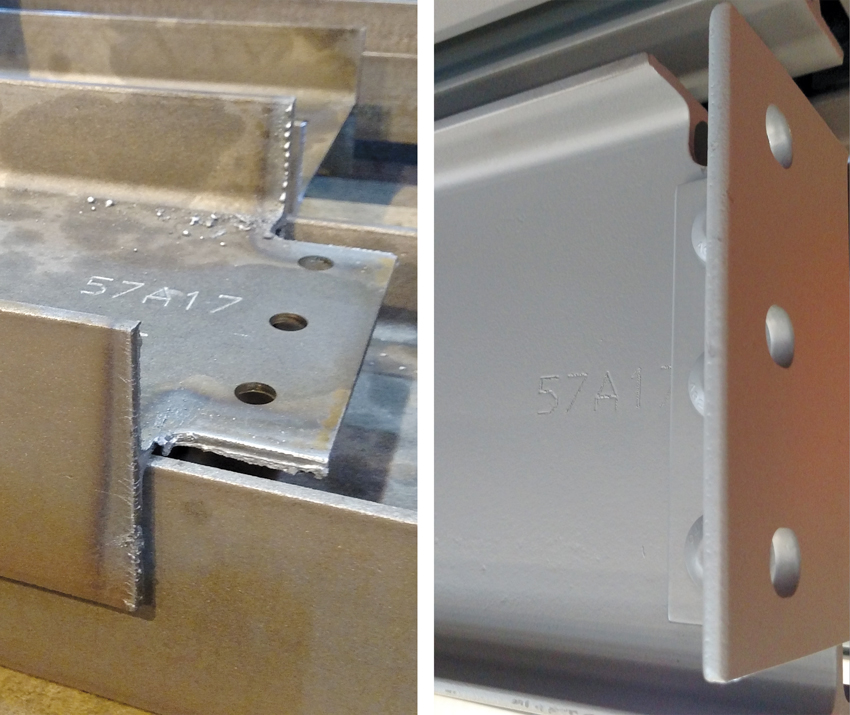
Photos courtesy of American Institute of Steel Construction (AISC)
Numbers are etched into a steel beam (left) during the fabrication process. After receiving a painted finish coat in the shop, the tracking number for the project can still be seen.
During fabrication and erection, steel members are marked for inventory and tracking purposes. These numbers are visible on the steel even through certain coatings unless AESS 2 or a higher category is specified. The marks can either be ground out, filled, or simply turned away from view.
Continuous welds are already included with AESS 1, but AESS 2 goes a step further by requiring greater consistency in the welding process. The latter expects additional care and refinement during fabrication and erection. AESS 2 calls for uniform and smooth welds, which entails a consistent appearance on all welds in view range but does not necessarily deem welds are to be ground smooth.
AESS 3: Feature Elements in Close View
A higher level of fabrication and erection is provided as the number of AESS category increases. AESS 3 represents the next level of characteristics, specifically for components within a viewing distance of 20 feet or less. This category includes all the requirements for AESS 1 and 2 along with a more specific attention to detail as exposed elements are visibly closer.
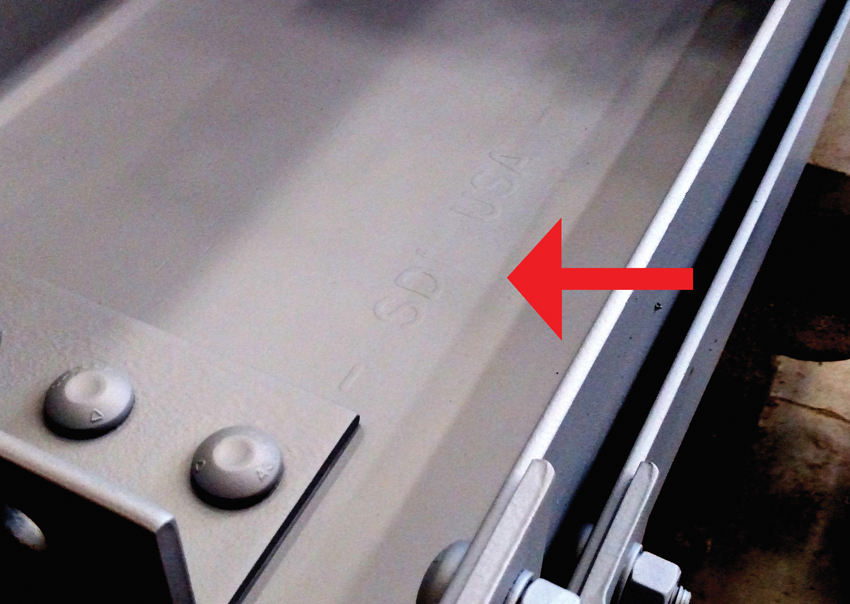
Photo courtesy of American Institute of Steel Construction (AISC)
Mill marks from Steel Dynamics Inc. (SDI) are visible through the painted finish on this structural steel member.
Steel is marked with slightly raised characters, called mill marks, when it is delivered to a fabricator from the mill. Mill marks identify the steel mill from which the component was produced. A raised or depressed surface on structural steel members is also created with butt and plug welds. These marks and visible welds are deemed undesirable in AESS 3 and are required to be removed from view, typically by grinding them out or filling any depressions. Grind marks on exposed steel are easily visible, but applying a surface coating nearly or completely eliminates their appearance.
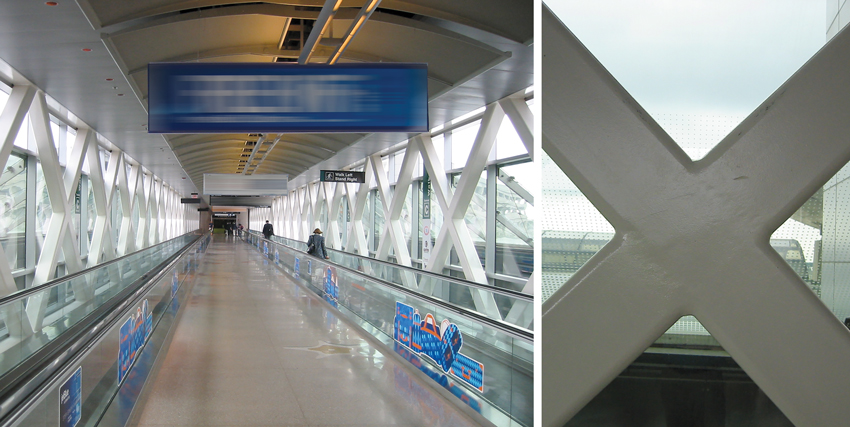
Photos courtesy of American Institute of Steel Construction (AISC)
Weld seams are to be less visible and consistently located in AESS Category 3. A series of intersecting hollow steel sections are visible along the pedestrian bridge (left) at Boston Logan International Airport. A close-up view (right) slightly shows the weld seams, which have been ground out consistently at each architecturally exposed member and coated with intumescent paint.
A weld seam is typically apparent when steel is joined together by welding. Welds are required to be continuous and consistent in appearance as noted in categories AESS 1 and 2. It is required that weld seams are to be less visible in AESS 3, as these elements are much closer in view range. Hollow structural steel (HSS) often includes weld seams as a typical method of connecting steel. An option to reduce visibility of seams is to simply orient them away from view. When such a strategy is not available, then aligning the seams in a consistent manner across all members is another solution. There are multiple methods of fulfilling this requirement, some which are less costly than others.
When two cross sections of steel come together, such as a column splice with connection plates, it is critical the sections align when in close view range. Lighting showcasing an AESS component can expose misaligned surfaces in an obvious and undesirable manner. AESS 3 specifically addresses components within range of touch or within closer view distances up to 20 feet away. Misalignments are not acceptable and require greater care in fabrication and erection to avoid these issues at cross-sectional surfaces that abut one another.
The tolerance for straightness must be tighter than the standard level, as noted under AESS 2. Tolerance requirements in AESS 3 go further to minimize the gaps between the components that have bolted connections. Greater precision during fabrication and erection is required so that these gaps are no greater than 1/8-inch and are uniform among all adjacent components.
The appearance of a bolted connection is not always desirable, especially when trying to achieve a seamless, “plastic” look. Determining the style of aesthetic is a prerequisite of choosing the appropriate AESS category. AESS 3 includes an option to utilize all-welded connections or reduce in the appearance of bolts. This can be achieved by coordinating the design intent with the structural engineer to use only welds for a particular connection. An alternate solution may be to hide the bolts by placing cover plates over them, a detail which should be clearly expressed in the contract documents.
AESS 4: Showcase Elements
The sculptural nature of steel is meant to be the main focus when specifying AESS 4. This category draws inspiration from the expression of form as the featured aesthetic in a project. Making material connections appear seamless in a project can sometimes be the most challenging to design and construct. The latter is also true of structure, especially when architecturally exposed structural steel is to have a very smooth and sleek finished appearance. It is generally understood that AESS 4 components may entail the highest premium over the previous categories, not only per the desired “glove” smooth finish, but more often due to the complexity of structural geometry. The design approach should be discussed between the architect and structural engineer in advance of selecting the AESS category.
The characteristics of the previous categories, AESS 1, 2, and 3, are all included with the selection of AESS 4. In AESS 3, it is acceptable to reduce the visibility of weld seams. The “glove” smooth finish desired for showcase elements in AESS 4 necessitate that weld seams are no longer visible. Certain structural steel shapes and sections, such as pipes or some types of hollow structural shapes, lend themselves to have fewer or no seams. If at all possible, turn the seam away from view for the most cost-effective strategy.
The smooth and contoured appearance of welds enhances the style of the more plastic look of AESS 4 components. Majority of steel designs in this category focus less on bolted connections and implement more welded connections for a seamless aesthetic. There are cases where welds may show through the back face of an exposed steel element. Locations where welds show through to the other side of the AESS component are to be addressed to reduce their undesirable appearance. Open holes placed in the steel members, often for the welding process, are to be closed off and smoothed out for a clean, finished surface.
More labor and time is often necessary during fabrication and erection to achieve the quality of AESS 4 compared to the previous categories. Surfaces that are in view range are to be free of imperfections. Filling any deviations with a body filler as well as sanding textured surfaces are methods of fabrication used in this category. This higher level of care and detail allows for glossy coats on steel to be a truly successful aesthetic in close view range, as depicted in the Brookfield Place Entry Pavilion in New York City.
AESS C: Custom Elements
Any deviation from the requirements of AESS 1, 2, 3, and 4 falls under the Custom category AESS C. Occasionally, there are situations when sharp edges do not need to be ground smooth or erection and painted marks are not required to be removed from view. Allowing this flexibility in choosing characteristics provides designers with greater freedom but also notifies steel fabricators and erectors that there is a noteworthy difference from the typical category requirements. Custom elements should be clearly defined in the contract documents with AESS C located as needed.
The 2016 AISC Code of Standard Practice recommends using Table 10.1, similar to the AESS Category Matrix shown previously in the course, as a checklist for architects to coordinate or customize AESS requirements with structural engineers. The matrix should be used to specify special requirements for AESS C in the contract documents.
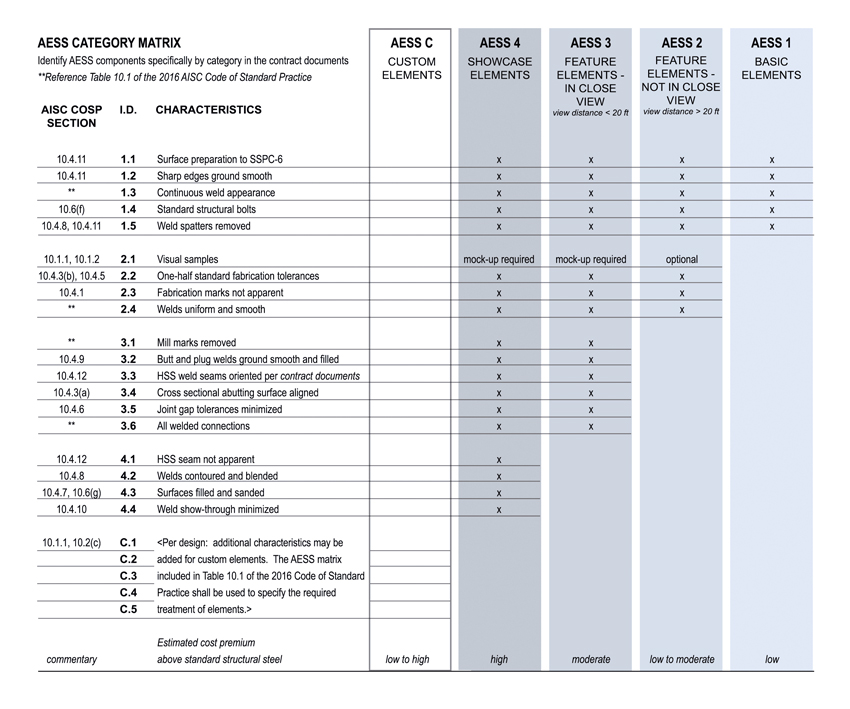
Image courtesy of American Institute of Steel Construction (AISC)
Note: I.D. numbers correspond to adjacent AESS image chart. Table 10.1 (similar) of the AISC Code of Standard Practice.

Images courtesy of American Institute of Steel Construction (AISC), except as noted
Note: Reference adjacent AESS Category Matrix for I.D. numbers and characteristics.
The Last Piece
The last portion of the AESS process is just as critical as a well-coordinated design phase. The 2016 AISC Code of Standard Practice addresses requirements for erection of AESS in Section 10. The higher-quality finish and treatment of AESS necessitates extra care and handling during transit and placement. The timeline for erection may be slightly longer when AESS is specified on a project. Erectors are tasked with assembling the steel with careful planning and methods to avoid damage to the finished product.
Conclusion
The decision to architecturally expose structural steel can add significant value to a building. Improvements in the 2016 AISC Code of Standard Practice satisfy the desire to create efficient and cost effective measures when implementing AESS on a project. The five categories (AESS 1, 2, 3, 4, and C) that distinguish architecturally exposed structural steel require sufficient evaluation and coordination in order to meet project expectations within budget and schedule. Establishing the same level of expectations between owners, architects, engineers, general contractors, fabricators, detailers, and erectors is critical to achieving the best end results for a project.
Resources
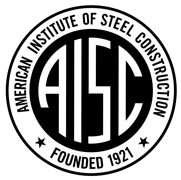
|
AISC is the leading advocate and trusted resource for American structural steel. Grounded in unsurpassed science, quality, and craftsmanship, our vibrant industry is ever-advancing and ever-improving. That’s why for nearly 100 years, AISC has proudly innovated with breakthrough research and applied technology for fabricators, engineers, architects, and the construction industry. We set the standard so you can focus on delivering visionary projects of the highest quality for your clients. As we move into our next 100 years, we’ll continue to advocate for, champion, and strengthen this vital industry. www.aisc.org
|













